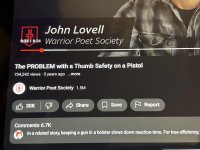Well Armed
Member
- Joined
- Jul 5, 2014
- Messages
- 1,101
- Reaction score
- 1,358
It's not rocket science, and 1911 owners, Beretta 92, CZ 75, our U.S. military with their Glock 19x and P320s, and a plethora of other militaries and law enforcement have been carrying and actually utilizing handguns with safeties for decades now in real self-defense shootings, wars, conflicts, and police encounters. They all train to swipe off the safety during the draw. It's not hard to do or as complicated as many in this thread are disingenuously trying to make it seem. You're statistically much, much, much more likely to have a negligent or even accidentally discharge than anyone's going to be in a fast-draw gun fight. Even then, it's not time-consuming to click the safety off from the time the gun leaves the pocket and is presented on target... Real-life military, law enforcement, and 1911 owners have been doing for decades in real gun fights, as opposed to a lot of the internet "experts" that live in the comfort of 1st world countries and have never shot anyone other than their mouth and paper.Describe the video. Is it the Wilson Combat one?
If so many of the scenarios he is describing would not happen with a pocket carry ccw firearm. If I draw my weapon I want that safety off. He is also talking about a safety that is easy to flick off quickly and specifically mentioning the sig which has no trigger safety. He mentioned a senario where someone was shot re holstering. Very Very rare and I think he said it was with a sig. He was also mentioning bad guys taking a gun away from a cop and not knowing how to fire it with the safety on. They wont even know we have a firearm till we draw and if so you better have it ready to fire. If you want the safety get it but you better be able to turn it off in your pocket before you draw on a bad guy.
I think with the BG2.0 safety there is more of a chance of the user needing to fire and not being able to turn the safety off in time or forgetting it was on.
The only reason I can think of why people are wanting a safety on the BG2.0 is because they are pocket carrying without a holster. Still not smart though IMO.
Heck, one more point. Someone who's drawing from the pocket has more time to swipe a safety off compared to someone that's drawing from the belt. If U.S. law enforcement agencies around the countries can successfully disengage one, or two in many cases, retention points on their duty holster before drawing their gun, then it should not be hard for able bodied and mind person to simply move their thumb in a downward motion while drawing their pistol.
Last edited:

